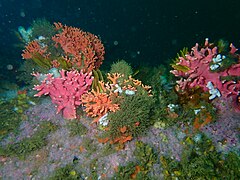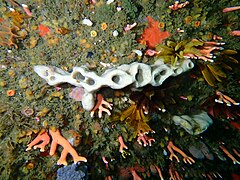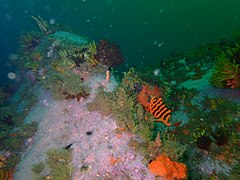The dive site Midway Ridge is an offshore rocky reef in the Off-Whittle southern reefs area on the central west side of False Bay, near Cape Town in the Western Cape province of South Africa.
Understand
[edit]
Found during a multibeam sonar survey and first dived in October 2022 by Wreckless Divers. Nice reef, spectacular topography.
Position
[edit]1 Midway Ridge: S34°15.116' E18°34.290', Southwest of Bruce's Mark, about halfway between Whittle Rock main reef and Bruce's Mark. A compact granite outcrop in the Off-Whittle southern reefs area, rising from about 46 m on the sand to about 37 m deep at the rounded top, running northwest-southeast, with several deep transverse cracks and steep sides. This site is not in a Marine Protected Area. A permit is not required.
Name
[edit]The name "Midway Ridge" refers to the position about halfway between the bigger reefs at Whittle Rock and Bruce's Mark.
Depth
[edit]Maximum depth is about 46 m on the sand. and the top of the ridge is about 37 m. (Average depth of a dive is likely to be about 40 m.)
Visibility
[edit]Visibility is likely to be much like at the other reefs of the Whittle Rock area. It is deep enough to usually be below the algal bloom and associated heavy plankton layer which often develops after a sunny period.
Topography
[edit]Large high-profile outcrop running northwest to southeast, broken by irregularly spaced deep transverse cracks, some quite wide. Top of ridge rounded to flattish, with relatively high points a bit east of the central area, and generally sloping down towards the ends. Northwest end somewhat lower and narrower than the southeast end.
Geology: Precambrian granite of the Peninsula pluton, surrounded by shelly sand
Conditions
[edit]The site is exposed to wind and waves from all directions, so should be dived in low swells and light winds, and is likely to be at its best in winter but there will also be opportunities during the rest of the year. This is an area which has a thermocline in late summer, and the visibility may be better at depth when there is an algal bloom in the surface water, caused by strong sunshine in summer, resulting in a top layer of poor visibility with clearer but dark water below.
Get in
[edit]The site is only accessible by boat. It is about 8.5? km from the slipway at Miller's Point, but boats may also leave from Simon's Town jetty. On a good day in a fast boat it is a bit less than a half hour run from Simon's Town Jetty, a distance of about 14.5? km. Occasionally boats may leave from Gordon's Bay Old Harbour or Harbour Island marina, which are both about 29.5? km away.
Do
[edit]Routes
[edit]No known routes. Start deep as you want to go, and ascend from the top of the reef.
See
[edit]Marine life
[edit]- Sponge
- Soft coral
- Sponges
- Sponges and noble corals
- Noble corals
- Sponge
- Top of the Reef at Midway Ridge
- Nippled sea fan
- Sponge
Features
[edit]The deep transverse cracks.
Photography
[edit]Macro with artificial lighting. and wide angle with natural lighting if you are lucky with visibility and natural illumination.
Stay safe
[edit]Hazards
[edit]There are no known site-specific hazards other than the depth. Most of the site is below the depth range usually accepted as suitable for recreational diving, or for emergency swimming ascent. Surface currents due to wind are likely and may take the divers away from the descent area during an ascent with decompression stops.
Skills
[edit]The competence to follow suitable decompression procedures is strongly recommended. This includes carrying and using appropriate gases and deploying a decompression buoy to mark the position of the divers during ascent.
Equipment
[edit]Adequate and reliable alternative breathing gas supply, as the depth is beyond the range for which emergency swimming ascent is a reasonable response. A decompression buoy is strongly recommended, and may be required by the service provider. A fully redundant emergency gas supply is recommended. Use of breathing gas mixtures appropriate to the depth is recommended,
Nearby
[edit]Other offshore dive sites of False Bay:
- 1 SATS General Botha
- 2 Off-Whittle Ridge
- 3 Whittle Rock
- 4 Bruce's Mark
- 5 Sandy-top Ridge
- 6 Southwood's Corner
- 7 Josh's Reef
- 8 Wreckless Ridge
- 9 Lonehill Reef
- 10 Deep South Whittle Reef
Back to the Alphabetical list of sites, or list of reef dive sites in the Whittle Rock and surrounds offshore area
Other regional dive sites:
- Dive sites of Table Bay and approaches,
- Dive sites of the Cape Peninsula west coast
- Dive sites of the Cape Peninsula east coast
- Dive sites of False Bay east coast
- Fresh water dive sites of the Cape Town Metropolitan Area











